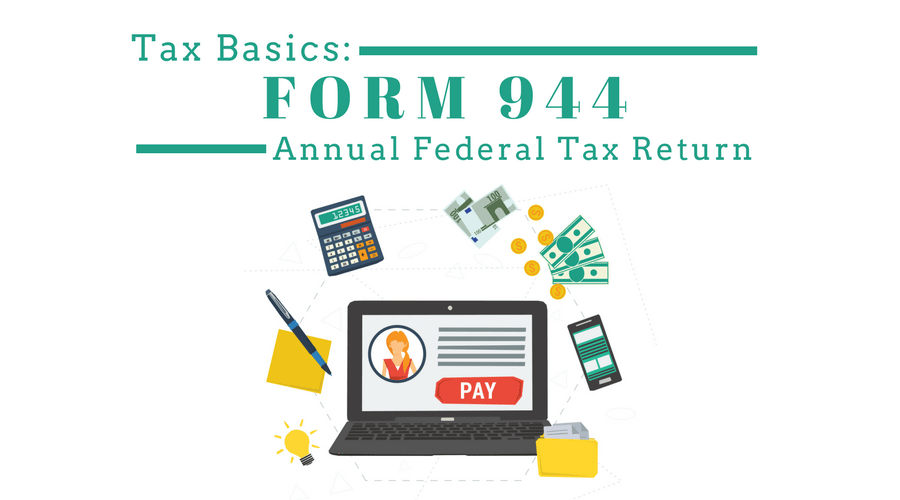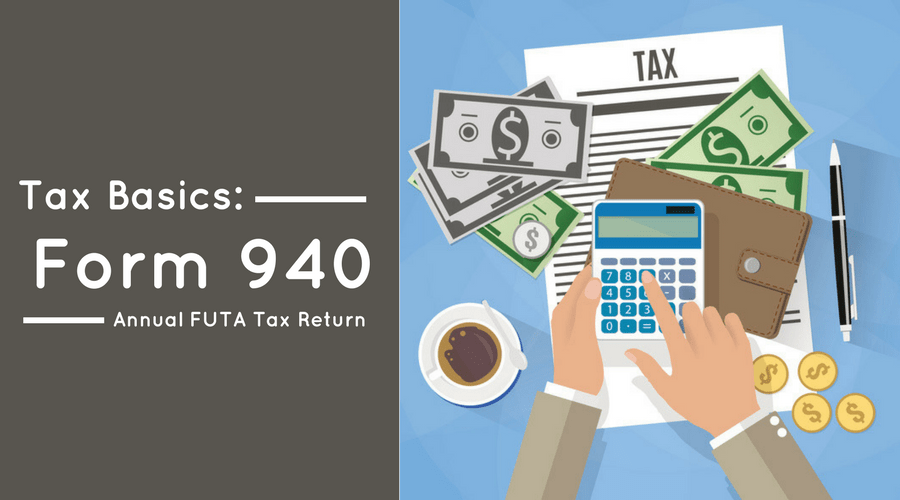Tax Basics: Form 944

This article was last edited on 10/23/2019. For updated information on Form 944, visit About Form 944, Employer’s Annual Federal Tax Return.
As an employer, you must withhold certain taxes from your employees’ paychecks, including federal income, Social Security, and Medicare taxes. You’re also responsible for paying the employer’s share of Social Security and Medicare taxes. The IRS allows the smallest businesses to file and pay these employment taxes annually, instead of quarterly, using Form 944.
You may be able to file Form 944 if your annual payroll tax liability is $1,000 or less. This will generally happen when you pay $4,000 or less in wages that are subject to employment taxes. The IRS will notify you, in writing, if you’re expected to file Form 944.
Form 944 reports:
- wages you’ve paid
- tips your employees have reported to you
- federal income tax withheld
- employer and employee portions of Social Security and Medicare taxes
- Additional Medicare Tax withheld
- adjustments to social security and Medicare taxes
Read also: A Beginner’s Guide to Social Security Taxes
How to Fill Out Form 944
Before you begin filling out Form 944, enter your employer identification number (EIN), your business’s legal name, trade name, and address. Go to the second page and enter your business’s legal name and EIN, so you don’t forget later.
- Line 1 – Enter any wages, tips, and other compensation paid to your staff during the year.
- Line 2 – Enter any federal income tax withheld on wages, tips, taxable fringe benefits, and supplemental unemployment compensation benefits.
- Line 3 – If you didn’t pay any wages, sick pay, or fringe benefits that were subject to Social Security tax, check the box on Line 3 and skip to Line 5.
- Line 4a – In Column 1, enter the total compensation paid that’s subject to Social Security tax. Don’t include any tips your staff reported to you. Multiply that amount by 12.4 percent and enter the result in the second column. This accounts for both the employer and employee portions of the tax.
- Line 4b – In the first column, enter any tips your team reported to you. These include cash tips, charged tips that you paid to your employees, and tips received from coworkers under a tip-sharing arrangement. Multiply this amount by 12.4 percent and enter the result in Column 2. Read also: How to Deal with Tips & Taxes
- Line 4c – Enter all compensation subject to Medicare tax in the first column. Then, multiply it by 2.9 percent and enter the result in Column 2. This accounts for both the employer and employee portions of the tax.
- Line 4d – If you paid any employee more than $200,000 during the year, you must withhold Additional Medicare Tax (AMT) at a rate of 0.9 percent on anything over $200,000. This tax is only imposed on the worker. Enter any amount paid over $200,000 in Column 1 and multiply it by 0. 9 percent. Then, enter the total in the second column.
- Line 4e – Add the second column from Lines 4a through 4d and enter the total on Line 4e.
- Line 5 – Add Lines 2 and 4e and enter the total.
- Line 6 – Enter employee shares of Social Security and Medicare tax amounts that resulted from current period adjustments. Adjustments may be caused by
- fractions of cents due to rounding
- a third-party sick pay payer withholding and depositing taxes for your staff
- taxes not collected on tips or group-term life insurance premiums paid for a former worker
- Line 7 – Add Lines 5 and 6 and enter the total. If the total is less than $2,500, you can pay the amount when you file Form 944, using Form 944-V, Payment Voucher. If the amount is $2,500 or more, you’ll have to deposit the funds through Electronic Funds Transfer (EFT) using the Electronic Federal Tax Payment System (EFTPS).
- Line 8 – Enter any payroll tax payments you’ve made during the year.
- Line 11 – If the amount on Line 7 is greater than the amount on Line 8, enter the difference. Typically, you’ll only have a balance due if Line 7 is less than $2,500.
- Line 12 – If the amount on Line 8 is greater than the amount on Line 7, enter the difference. Choose whether you want a refund, or if you’d prefer for the overpayment amount to be applied to your next return.
- Line 13 – If the amount on Line 7 is $2,500 or higher, check the second box. If you’re a monthly depositor, enter your tax liability for each month, then enter your total annual liability. The total on Line 13m should equal the amount on Line 7. If you’re a semi-weekly depositor, complete Form 945-A, Annual Record of Federal Tax Liability.
- Line 14 – You’ll only check the box on line 14 if your business closed during the year or if you stopped paying wages. Enter the last date you paid wages to tell the IRS that this will be your final return.
- Part 4 – If you would like an employee, a paid tax preparer, or anyone other than yourself to discuss Form 944 with the IRS, check, “Yes.” Enter the name, phone number, and a five-digit personal identification number (PIN) of the person the IRS may speak to. The person you select can choose any five numbers for their PIN.
- Part 5 – Don’t forget to sign the form before filing it.
- If you’re a sole proprietor, only you can sign.
- If your business is a corporation or an LLC treated as a corporation, the president, vice president, or other principal officers duly authorized may sign.
- If your business is a partnership or an LLC treated as a partnership, a responsible and duly authorized partner, member, or officer may sign.
- If your company is a single-member LLC treated as a disregarded entity, the owner or a principal officer duly authorized may sign.
- Paid preparer information – If you paid someone to prepare your Form 944, they must sign the form and provide information, including their preparer tax identification number (PTIN).
When to file
Form 944 is due by January 31 of the following year. For example, for the tax year 2019, you will need to file by January 31, 2020. If you’ve made all your payments throughout the year on time and in full, you may file by February 10.
Read also: Tax Due Dates
How to make a deposit
If your tax liability is $2,500 or less for the year, you likely don’t have to make regular deposits. Instead, you can submit your payment with Form 944, using Form 944-V. If your liability exceeds $2,500 for the year, make your deposits via EFT.
Read also: How to I deposit payroll taxes for my small business?
Choosing to file Form 944
If the IRS requires you to file Form 941 each quarter, but if you believe that your payroll tax liability for the year will be $1,000 or less, you may request to file Form 944 instead. You can call the IRS at 800-829-4933 or send them a written request between January 1 and March 15. You cannot file Form 944 until you have written notice from the IRS.
Read also: 7 Tips for Filing IRS Form 941: Employer’s Quarterly Federal Tax Return


